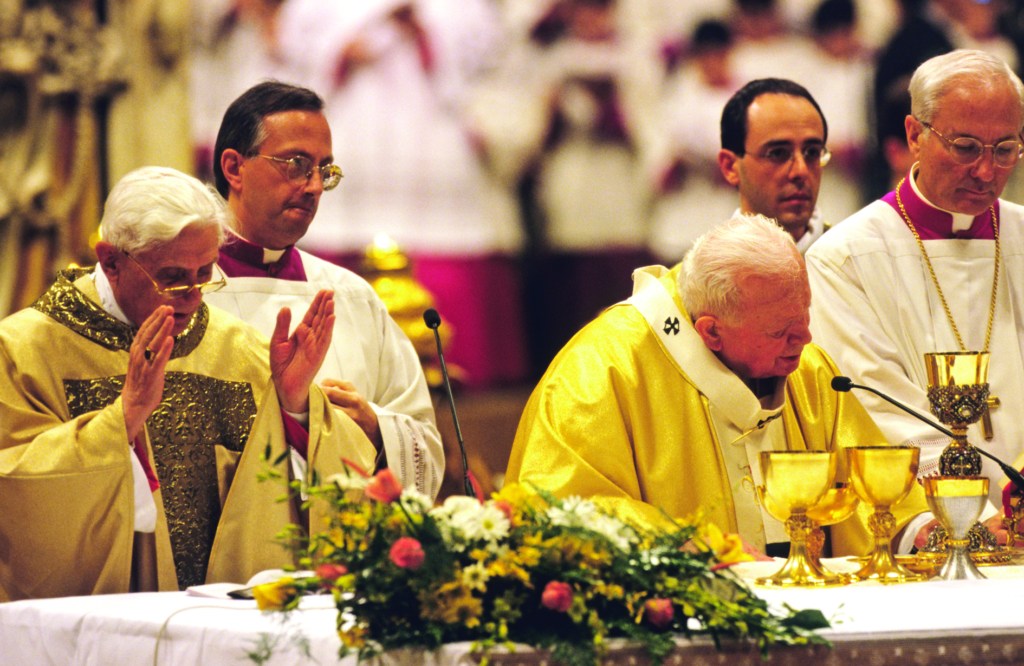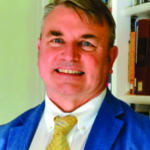He was a standard-bearer in our war with the spirit of the world
By Joseph Pearce

March 30, 2002 — St. Peter’s Basilica, Pope John Paul II and Cardinal Joseph Ratzinger are seen together at the altar during the Easter Vigil (Photo Grzegorz Galazka)
“The high tide,” King Alfred cried. “The high tide and the turn!”
This battle cry from Chesterton’s epic poem The Ballad of the White Horse was shouted by Alfred the Great at the moment when the Viking hordes were turned back by the resurgent Christian forces under his command. These lines spring to mind when we think of the effect of the election of St. John Paul II at a time when it appeared that the modernist hordes were about to overrun the Church in the name of the so-called “spirit” of Vatican II.
The immediate impact of John Paul’s election was documented early in his pontificate by the historian Paul Johnson in his book Pope John Paul II and the Catholic Restoration. Published in 1982, only four years after JPII’s election, Johnson’s book makes no mention whatsoever of Cardinal Joseph Ratzinger. This is hardly surprising, considering that Johnson was probably writing his book prior to John Paul’s appointment of Ratzinger as the Prefect of the Sacred Congregation for the Doctrine of the Faith in November 1981. Thereafter, however, John Paul II and Cardinal Ratzinger would form an inseparable partnership in the ongoing restoration of orthodoxy and tradition after the heterodoxy and liturgical vandalism of the previous two decades. The two men stood together in holy alliance as a dynamic duo defending the Faith from those seeking to undermine it.
On the feast of the Assumption, August 15, 1984, Cardinal Ratzinger gave an extensive interview to the Italian writer Vittorio Messori. The book that emerged from their discussion, published in English as The Ratzinger Report, offered the world a unique insight into the Cardinal’s view of the state of the Church less than three years after his appointment as Prefect of the Sacred Congregation.
Asked whether his opposition to the Church’s “openness” to the world was a regressive return to the old spirit of opposition to the world, pro Ecclesia contra mundum, Ratzinger was defiant in his defense of the Church: “It is not Christians who oppose the world, but rather the world which opposes itself to them when the truth about God, about Christ and about man is proclaimed. The world waxes indignant when sin and grace are called by their names. After the phase of indiscriminate ‘openness’ it is time that the Christian reacquires the consciousness of belonging to a minority and of often being in opposition to… that mentality which the New Testament calls — and certainly not in a positive sense — the ‘spirit of the world.’ It is time to find again the courage of nonconformism, the capacity to oppose many of the trends of the surrounding culture, renouncing a certain euphoric post-conciliar solidarity.”
Here was Ratzinger at his most outspoken, the voice of the Church Militant, the voice of a church at war with the spirit of the age, fighting with a crusading spirit for the true and unchanging spirit of the Gospel.
If the publication of The Ratzinger Report set the defiantly orthodox tone of Cardinal Ratzinger’s role in his dynamic duet with St. John Paul II, the publication of The Spirit of the Liturgy at the turn of the new millennium marked a watershed moment in which the future Pope placed his faithful heart and mind at the service of liturgical tradition.
As early as 1975, only 10 years after the Second Vatican Council, Ratzinger had written of the need to oppose the “rationalistic relativism, confusing claptrap and pastoral infantilism” which were degrading the liturgy “to the level of a parish tea party and the intelligibility of the popular newspaper.” (From The Ratzinger Report, p. 121)
Most notably, the disappearance of the use of Latin from the liturgy was in clear contravention of the teaching of the Council in Sacrosanctum concilium, which stated unequivocally that “the Latin language … is to be preserved” in the liturgy.
Apart from this unauthorized abandonment of Latin, many post-conciliar liturgies lacked any trace of beauty, especially in the way in which traditional sacred music, such as Gregorian chant or polyphony, had been abandoned and banished in deference to what Ratzinger termed “utility music,” “catchy tunes” and other ditties to the Deity which rarely ascended above the level of the banal.
In “the splendor of holiness and art” the Church bears witness to the truth through the good and the beautiful: “If the Church is to continue to transform and humanize the world, how can she dispense with beauty in her liturgies, that beauty which is so closely linked with love and with the radiance of the Resurrection?” The Church needed to be “a place where beauty – and hence truth – is at home.” Without such beauty “the world will become the first circle of hell.”
One of the major causes of liturgical confusion was the disorientation of the priest during Mass. Whereas it had been customary for the priest to face the same way as the people, towards the east (ad orientem), the liturgical modernists turned the priest around so that he faced the opposite way to the people (versus populum), turning his back on the east. Instead of the priest and the people being united in praise, facing the same way, the priest now faced the people and became the central focus of the liturgical “performance.”
He was now the star of the show with the sanctuary being transformed into the stage on which he performed: “The turning of the priest toward the people has turned the community into a self-enclosed circle. In its outward form, it no longer opens out on what lies ahead and above, but is closed in on itself.”
At its worst, the liturgy had ceased to be Christocentric but had become narcissistically anthropocentric, a reflection of man’s idolatrous worship of himself.
This was not as it should be, prompting Ratzinger to stress the need for a reorientation of priest and people towards Christ. As steeped in the history of the Church as he was in her theology and philosophy, he stressed that praying towards the east was regarded as being an apostolic tradition in the early Church, a practice that “goes back to the earliest times and was always regarded as an essential characteristic of Christian liturgy (and indeed of private prayer).”
“The world waxes indignant when sin and grace are called by their names”
–Benedict XVI
Reminding us that the Second Vatican Council had said nothing about “turning toward the people,” Ratzinger asserted that “wherever possible, we should definitely take up again the apostolic tradition of facing the east, both in the building of churches and in the celebration of the liturgy.” In particular, “a common turning to the east during the Eucharistic Prayer remains essential.”
Cardinal Ratzinger’s masterful book on the spirit of the liturgy was a call to action.
When, as Supreme Pontiff, he issued his Apostolic Letter, Summorum Pontificum, given Motu Proprio, he sought to put the principles enunciated in The Spirit of the Liturgy into practice, restoring the splendor of liturgical tradition.
Even as he was calling on the faithful to kneel for Communion, he was exhorting them to stand and fight for the ancient traditions of the Church’s worship.
Here was a true leader of the Church, the closest ally of St. John Paul II, who was prepared to take the fight to the monsters of modernity.
Like a modern St. George coming to the defense of the Bride of Christ, a true damsel in distress, Benedict XVI had wielded his sword of truth and his lance of reason in a battle with the dragon of disorientation.
Although those who remain disoriented have sought in recent years to once again point the Church in the wrong direction, they are doomed and destined to fail. The gates of hell will not prevail. The tide has turned.
 Joseph Pearce is an internationally acclaimed author, television host, editor of the St. Austin Review, series editor of the Ignatius Critical Editions, senior contributor at The Imaginative Conservative, and current holder of the Newman Chair in Catholic Studies at Thomas More College of Liberal Arts.
Joseph Pearce is an internationally acclaimed author, television host, editor of the St. Austin Review, series editor of the Ignatius Critical Editions, senior contributor at The Imaginative Conservative, and current holder of the Newman Chair in Catholic Studies at Thomas More College of Liberal Arts.






Facebook Comments